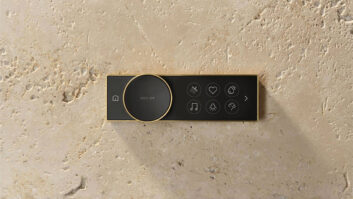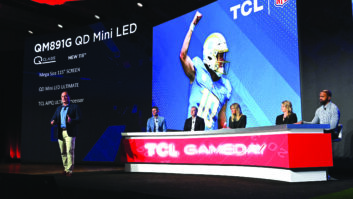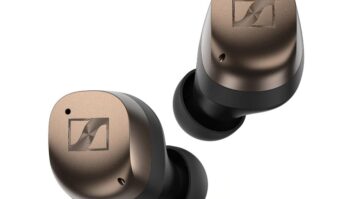The chairman of the WirelessHD (WiHD) consortium expects suppliers to announce plans for products incorporating WiHD at International CES in January.
WiHD technology is an in-room wireless technology that replaces wired HDMI connections among audio and video components. The technology, which delivers uncompressed copy-protected high-definition video at resolutions up to 1080p, would enable HD streaming among different-brand components within a room up to 10 meters away. The technology isn’t designed to penetrate walls to deliver multiroom video.
“My impression is that [major suppliers] will commit [to the technology] at CES,” chairman John Marshall told TWICE during a demo of a 1-inch by 1-inch by 4-inch WiHD module developed by SiBeam. The module is sized to fit into the front panels of flat-screen TVs, DVRs and audio products such as A/V receivers (AVRs). Marshall is also SiBeam’s sales and marketing VP.
The demo, which took place at an enterprise IT trade show here, followed an announcement that the Digital Transmission License Administrator (DTLA) organization adopted a version of its 128-bit digital transmission content protection (DTCP) encryption technology to ride on a WiHD carrier.
Marshall said he expects WiHD adapters and video products with embedded WiHD to appear on the market at about the same time, initially to cut the HDMI cord between flat-screen TVs and cable- and satellite-TV set-top boxes, DVRs and other video sources. Equipped with WiHD, the sources could be located in less conspicuous areas of a room because they don’t need to be physically connected by cable to a TV. They could also be placed behind closed A/V cabinet doors (but not metal doors) and still deliver their signal to the display, Marshall noted.
The chairman also sees potential for WiHD use in AVRs. “If you use it in an A/V receiver, [another WiHD device] will auto-discover the A/V receiver and send [multichannel] audio to the receiver and video to the display,” he explained. Alternately, audio and video could be transmitted to the AVR, which would then transmit the video to the display.
In SiBeam’s view, laptop PCs and digital camcorders equipped with WiHD could begin appearing within five years of the first WiHD-equipped TVs, Marshall said. Laptops could send video wirelessly to displays for business presentations, he noted.
Marshall called WiHD the “only wireless solution promoting uncompressed, no-loss high-definition video, including 1080p,” which requires a bandwidth of 3.6Gbps to 3.8Gbps. Other technologies use compression, and one other doesn’t use compression but nonetheless reduces chrominance and luminance because its bandwidth is narrower than WiHD’s 4Gbps bandwidth, he said.
As the only wireless technology authorized to use DTCP, which is more robust than DTLA’s 56-bit HDCP encryption, WiHD is permitted to stream HD video for copying, not just for display, he continued. “The scenarios that are most critical are recording content that flows into the home to a DVR or recorder or taking content from a fixed-location device to a portable device, such as set-top box to PC or to a gaming device such as NintendoDS or PSP,” he said. “For the portable devices, the module will definitely shrink over time.”
In addition, DTCP inclusion enables WiHD to stream two HD programs simultaneously, although WiHD bandwidth allows for only two 1080i streams at a time, Marshall said. That capability could be useful in sports bar settings but also in the home, he said. “I might want to stream two sources to a single TV so that you can watch both via picture-in-picture (PIP),” he explained. “Alternately, two consumers playing a racing game on a game console could dedicate the left side of a split-screen view to one display and the right side of a split-screen view to a second display.
Other companies that have demonstrated wireless HD transmission have demonstrated only HDCP single-stream transmission, Marshall said.
WiHD promoter members include Sony, Panasonic, Toshiba, Samsung, SiBeam, NEC and chipmakers Intel and Broadcom. Adopter members include Denon, Onkyo, Pioneer, Sharp and Kyocera, Marshall said.













